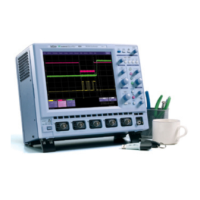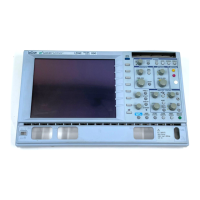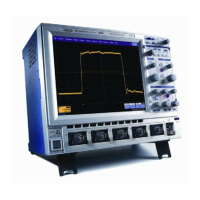X-Stream Operator’s Manual
WM-OM-E Rev I 235
The dBm Power Spectrum:
where M
ref
= 0.316 V (that is, 0 dBm is defined as a sine wave of 0.316 V peak or 0.224 V rms,
giving 1.0 mW into 50 ohms).
The dBm Power Spectrum is the same as dBm Magnitude, as suggested in the above formula.
dBm Power Density:
where ENBW is the equivalent noise bandwidth of the filter corresponding to the selected window,
and Delta f is the current frequency resolution (bin width).
6. The FFT Power Average takes the complex frequency-domain data R'
n
and I'
n
for each
spectrum generated in Step 5, and computes the square of the magnitude:
M
n
2
= R'
n
2
+ I'
n
2
,
then sums M
n
2 and counts the accumulated spectra. The total is normalized by the number
of spectra and converted to the selected result type using the same formulas as are used
for the Fourier Transform.
Glossary
This section defines the terms frequently used in FFT spectrum analysis and relates them to the
oscilloscope.
Aliasing If the input signal to a sampling acquisition system contains components whose
frequency is greater than the Nyquist frequency (half the sampling frequency), there will be less
than two samples per signal period. The result is that the contribution of these components to the
sampled waveform is indistinguishable from that of components below the Nyquist frequency. This
is aliasing.
The timebase and transform size should be selected so that the resulting Nyquist frequency is
higher than the highest significant component in the time-domain record.

